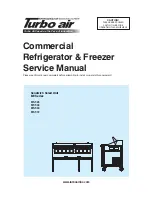
English GENERAL USER’S MANUAL REFRIGERATORS
fi160929
11
GB
18 Defrosting
a) Fridge
Whilst the compressor (refrigeration unit) is running,
frost and condensation can form on the rear wall. These
do not have to be removed as the fridge automatically
defrosts.
The defrost water runs from the channel via the drain
hole, into a vessel from which it evaporates.
Some refrigerator models have no automatic
defrosting.
These appliances can be recognised by the fact that
they have no run-off channel (with a hole) for the
defrosted water on the internal rear panel of the
refrigerator (
see
Appliance components Section (6).
These refrigerators must be defrosted by hand from
time to time. The procedure is similar to that used for
defrosting a freezer compartment
(see Chapter 17 b)
Freezer compartment)
b) Freezer compartment
(where fitted)
The freezer compartment with static function does not
automatically defrost as the frozen produce is not
permitted to defrost.
Defrost the freezer compartment occasionally, at the
latest however when a ca. 5 cm thick coating of ice has
formed. Carry out the actions described in the chapter
“Cleaning and care“ and the following steps.
For appliances with no-frost function (frost free)
this process is not required.
Potential hazards
Never use electrical appliances such as hairdryers,
hot air fans, steam cleaners, defrosting sprays or
open flames (e.g. candles) for defrosting the
freezer
compartment.
The plastic interior could melt and the emerging foam –
gas could be ignited by sparks or open flame.
Never use a steam cleaning appliance to melt
coatings of ice in the appliance (extremely high risk
of electric shock)
Hints
Remove the frozen produce and wrap it in several
layers of newspaper or blankets.
Keep the frozen produce in a cool place until the
freezer compartment is once more ready to use.
Leave the door of the freezer compartment open.
The layers of frost and ice in the freezer compartment
are formed through normal operation. After a certain
thickness is exceeded, these act as insulation and
impair the transfer of cold.
Do not scrape off this frost or ice coating as this can
damage the evaporator surface.
Carry out defrosting as quickly as possible to prevent
the removed produce from defrosting.
Continuously remove the water with a sponge
or pull out and empty the water tray underneath, in the
fridge compartment (not fitted to all models)
Pull out the plug – where fitted - from the water drain
hole and replace the water tray in its guideway.
You can speed up the defrosting by placing a vessel
of hot (not boiling) water with a pot stand in the freezer
compartment. In this case close the freezer
compartment door.
Take care that the water tray – where fitted – does not
overflow.
When the freezer compartment is fully defrosted,
empty the water collected in the tray into your kitchen
sink.
Replace the plug in the water drain hole and replace
the water tray.
Wipe the freezer compartment dry and replace the
produce.
Re-connect the power supply to your appliance.
Switch the appliance back on with the temperature
controller (see chapter “Switching on/off –
Temperature selection“) and – where fitted – press the
fast freeze- and or the fast cooling button (see chapter
“
Super-cooling Super freezing function
“
Close the appliance door.
19 Troubleshooting guide
High quality manufacturing processes and the use of
the latest refrigerating and freezer technology will
basically ensure the trouble-free functioning of your
appliance.
If you suspect any fault, before contacting your nearest
service department directly or via your dealer, make
sure you have followed all instructions and advice given
in this user manual.
The compressor (also known as the refrigerating
motor) must not operate continuously.
It is controlled by a thermostat which you set on the
temperature dial and switches on automatically when
the set temperature in the appliance is exceeded and
switches off automatically when it is reached again.
Noise can be heard in every compressor - refrigerating
system when it is switched on. These noises are
produced when the motor in the compressor is running
and by the refrigerant flowing through the refrigerating
system circuit. These noises are normal and do not
indicate any fault in the functioning of your appliance.
In unheated rooms
and in cold weather conditions,
condensation can build up on the outer walls of the
appliance.
This does not mean there is a fault and it will disappear
when the temperature increases.
Содержание GKE 144A+
Страница 19: ......






































